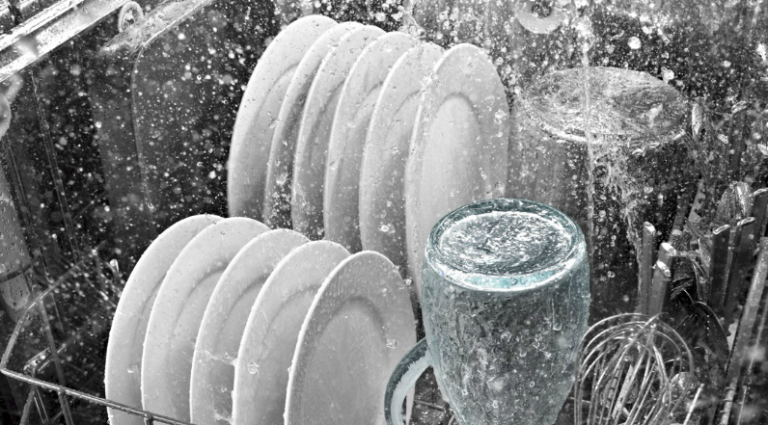How does a dishwasher work step by step?
Dishwashers operate as complex machines that utilize a combination of water, heat, and detergent to clean dishes effectively. The interior of a dishwasher functions as a carefully orchestrated cleaning chamber, where multiple processes work in tandem to remove food particles, grease, and bacteria from your dishes. This article will delve into the inner workings of dishwashers, exploring the importance of hot water, the stages of the cleaning cycle, and other crucial aspects of dishwasher operation.
The Importance of Hot Water

Hot water plays a pivotal role in the dishwashing process. Dishwashers-heat water enhances cleaning efficiency. Hot water-dissolves grease more effectively than cold water. The optimal temperature-ranges between 120°F and 150°F (49°C to 66°C).
| Temperature Range | Benefits |
|---|---|
| 120°F – 130°F (49°C – 54°C) | Adequate for most cleaning tasks |
| 130°F – 140°F (54°C – 60°C) | Improves grease dissolution |
| 140°F – 150°F (60°C – 66°C) | Provides sanitizing capabilities |
Hot water-also activates detergent enzymes. These enzymes-break down protein-based stains and food particles. Additionally, hot water-helps in drying dishes more quickly and efficiently.
A Dishwasher’s Cleaning Cycle
The dishwashing process consists of several distinct phases, each serving a specific purpose in the cleaning process.
1. Pre-wash/Rinse

The pre-wash cycle-initiates the cleaning process. During this stage:
- Dishwasher-sprays cold or lukewarm water onto dishes
- Water jets-remove loose food particles and debris
- Pre-wash-prevents food from baking onto dishes during main wash
This initial rinse-prepares dishes for more thorough cleaning in subsequent cycles.
2. Main Wash
The main wash cycle-forms the core of the cleaning process. In this phase:
- Dishwasher-fills with hot water
- Detergent dispenser-releases cleaning agents
- Spray arms-distribute water and detergent mixture
- Water pressure and temperature-increase for optimal cleaning
The main wash typically lasts 20-30 minutes, depending on the selected cycle and dishwasher model.
3. Final Wash and Rinse
The final wash and rinse cycle-ensures thorough cleanliness and removes any remaining detergent residue. During this stage:
- Dishwasher-drains dirty water from main wash
- Fresh hot water-rinses dishes
- Rinse aid-may be dispensed to improve drying and prevent water spots
Some Best KitchenAid Dishwashers feature additional rinse cycles for enhanced cleaning performance.
Other Things to Know About a Dishwasher

Understanding the following aspects can help you maximize your dishwasher’s efficiency and longevity:
- Water Usage: Modern dishwashers-consume less water than handwashing. An average dishwasher-uses 3-5 gallons (11-19 liters) per cycle.
- Energy Efficiency: ENERGY STAR certified dishwashers-use 12% less energy and 30% less water than standard models.
- Filtration System: Dishwashers-employ filters to trap food particles. Regular cleaning of these filters-ensures optimal performance.
- Drying Methods: Different drying methods include:
- Heated drying (using a heating element)
- Condensation drying (utilizing residual heat)
- Fan-assisted drying
- Loading Techniques: Proper loading-maximizes cleaning efficiency. Dishes-should be arranged to allow water and detergent to reach all surfaces.
| Dishwasher Part | Function |
|---|---|
| Spray Arms | Distribute water and detergent |
| Heating Element | Heats water and assists in drying |
| Detergent Dispenser | Releases cleaning agents at appropriate times |
| Rinse Aid Dispenser | Dispenses agent to improve drying and prevent spots |
| Filters | Trap food particles to prevent recirculation |
Understanding these components and processes can help you troubleshoot issues and maintain your dishwasher effectively.
In conclusion, the interior of a dishwasher serves as a sophisticated cleaning environment where hot water, detergent, and mechanical action combine to clean your dishes thoroughly. By comprehending the cleaning cycle stages and the role of various components, you can optimize your dishwasher’s performance and ensure sparkling clean dishes every time. Whether you’re considering Best KitchenAid Dishwashers or another brand, knowing how these appliances function can guide you in making informed decisions about usage and maintenance.

Michael Thompson is a highly skilled appliance technician specializing in KitchenAid dishwashers. With many years of experience, Michael is renowned for his expertise in handling various models of KitchenAid dishwashers, ensuring optimal performance and longevity. His dedication to customer satisfaction and in-depth knowledge of appliance technology make him a trusted figure in his community. Michael’s commitment to quality service has earned him a reputation as one of the best in his field.






